SO, IS THERE ANY SIGNIFICANCE IN THE AZIMUTHS OF 162-DEGREES
& 342-DEGREES?
Well yes, there's tremendous code bearing significance in this
alignment, which was incorporated numerically into the Great Pyramid of
Egypt and in the azimuth angles of the "Station Stones"
at Stonehenge in Southern England.
When Stonehenge was first built, four surveying stones were
put in place and the entire site was then constructed relative to these precisely
located positions.
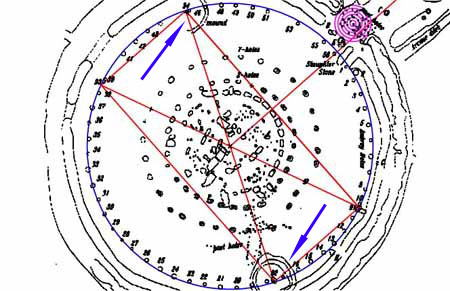
The blue arrows show how two of the Station Stones at Stonehenge
were situated on mounds at 162-degrees and 342-degrees azimuth, respectively,
relative to the centre position of Stonehenge. The same alignment was used
in setting up Koru PA's standing stone circle hubstone position, relative
to the cone position of Mt. Taranaki.
The PHI ratio of 1.6180339 to 1 was very important to ancient
civilisations and had to be remembered at all cost. A reciprocal form of the
PHI ratio was used for making measuring vessels that would accurately contain
exact cubic inch measures of dry or wet goods (bushel barrels for grain or
amphora's for wine, etc.). To read about the coded number system that was
incorporated into Weights, Measures & Volumes, see: http://www.celticnz.co.nz/Weights_Measures_Volumes/Weights_Measures.htm
It is important to note that the British Standard inch &
foot are incredibly old and were associated, by direct ratio, to the cubits
used by all of the early cousin nations of the ancient Mediterranean. Indeed,
the selfsame inch was shared by all of the cousin nations. For this reason,
the length of the Great Pyramid of Egypt can be rendered equally in the following
terms.
- 756 British Standard feet of 12-inches each or 9072-inches.
- 360 Assyrian cubits of 25.2-inches each or 9072-inches.
- 720 Greek feet of 12.6-inches each or 9072-inches.
- 72 Hebrew Reeds of 10.5 feet each or 9072-inches.
- 540 old Hebrew cubits of 16.8 inches each or 9072-inches
- 440 Egyptian Royal Cubits of 1.718181818 feet each (1 & 79/110ths)...this
was a special navigational cubit, designed for mnemonic reference to the equatorial
size of the Earth. Under this system, one circumnavigation of the Great Pyramid
(3024 feet) represented 1/2 of one minute or equatorial arc.
- 432 Hebrew or Celtic Royal Cubits of 21-inches each or 9072-inches.
These increments represent only a few that were shared and used by the cousin
nations for all manner of astronomical cycle or geodetic/ navigational calculations.
Professor Alexander Thom discovered an increment to be repetitively present
in the distances between stone components of the very weather worn, ancient
British monuments. This increment he dubbed the "Megalithic Yard"
and assigned a value of approximately 32.4-inches. Thom's Megalithic
Yard virtually duplicated the ancient Vara of "Iberia"
(meaning "Hebrews")* which was the former name for Spain. The
Gaz measurement of Northern India is also virtually identical to Thom's
Megalithic Yard and, although each is now slightly drifted from their original
size, all seem to stem from one common origin of 32.4-inches (32 & 2/5ths
inches).
Thom's Megalithic Yard was 2 X 16.2-inches. At the Great Pyramid, this would
equate to:
- 756 feet = 280 Megalithic Yards of 32.4-inches each
- 756 feet = 560 half Megalithic Yards of 16.2-inches each.
The increment of 16.2-inches is simply a rounded form of the PHI ratio
(1.6180339 rendered 1.62) and, by incorporating this measurement into ancient
structures, they could be said to symbolically or mnemonically represent PHI
in their dimensions. Within British monuments, like Stonehenge, important measurements
will comply to an increment divisible by 16.2-inches. For example, the Sarsen
Circle lintel ring (30 stone lintels lying horizontally atop sarsen stone supports)
had a design outer length of 11.52 feet (11 & 13/25ths feet...138 &
6/25ths inches) per lintel each (average) and an inner length of 10.5 feet (one
Hebrew Reed) per lintel each. This meant that the outer circumference was 345.6
feet (256 X 16.2-inches), while the inner circumference was 315-feet (half a
Greek long stadia of 630 feet) or 233 &1/3rd increments of 16.2-inches.
Under the Great Pyramid's geodetic system the outer rim of the Sarsen circle
in England was 1/378000th of the equatorial size of the Earth. Note:
378 X 2 = 756.
At Stonehenge there are very profound examples of the use of the PHI ratio
in the design configuration of the main circles. For example: A marker stone
sits on the "Avenue" of Stonehenge and it's distance from the
centre of the site would mark the edge of a circle 466 feet in diameter.
If this diameter circle is reduced by 1.6180339 (PHI), then the new diameter
achieved is 288 feet. The Aubrey Circle, with its 56 post positions,
is 288 feet in diameter. If the Aubrey Circle is reduced by PHI, then
the result is 178 feet diameter. This is the width of the "Y"
Holes Circle. Again, if this is reduced by PHI , then the next circle down
would have a diameter of 110 feet. The very famous Sarsen Circle,
with its high standing megaliths and overhead linel stones is 110 feet
in diameter. Another way that this works mathematically is: 466' - 288' =
178'; 288' - 178' = 110'.
*Footnote: The original Hebrews, occupying Canaan or Israel, were part
of the European group of cousin nations, which once ranged from Northern India
to Egypt and its environs. Jewish scholars acknowledge that the era of the Hebrews
ended when the era of the Jews (late era Babylonians who conquered and occupied
Judea/ Israel) began (600 BC).
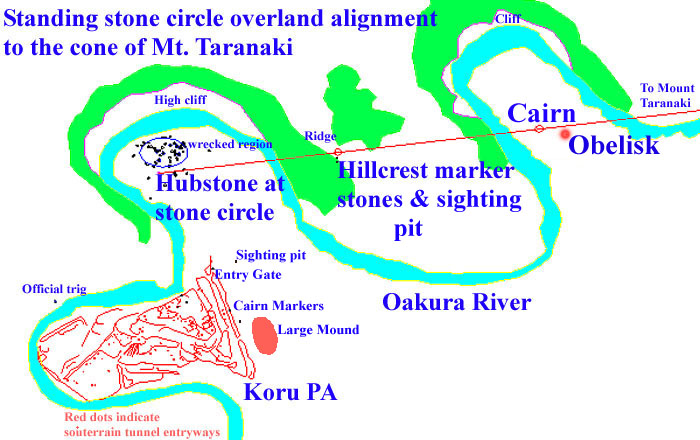
A representation of Koru PA, its "standing stone circle"
component and overland alignment to the "benchmark" or "landmark"
surveying position on the peak of the dormant volcano, Mount Taranaki
(undoubtedly, originally named in homage to Taranaich
...the ancient Pictish god of thunder, lightening and fire...also known
as Taranis in ancient France).
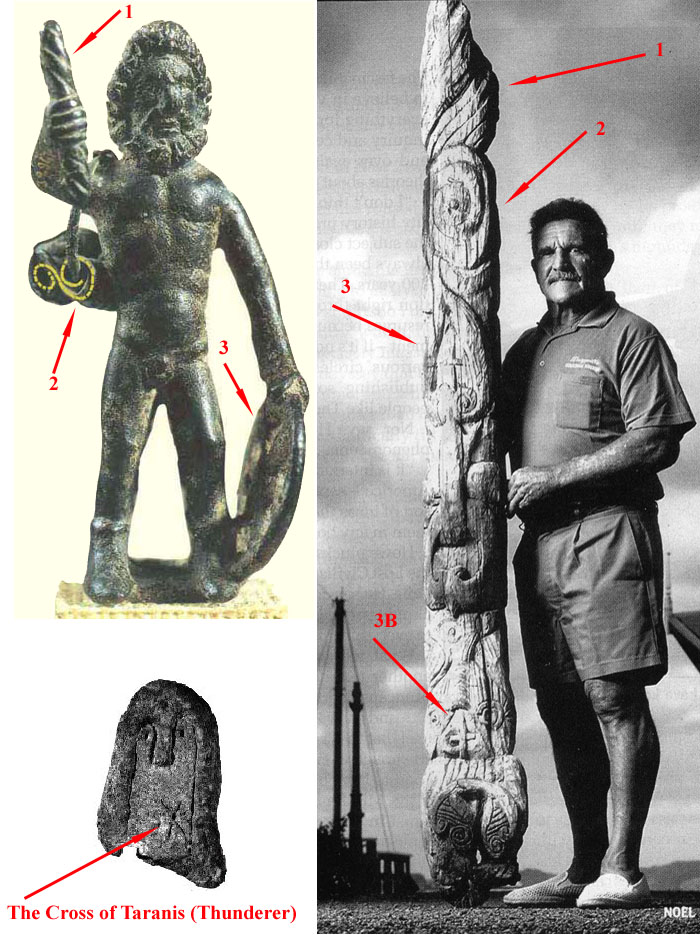
In the picture to the upper left is shown a statuette, found
in France, which depicts the ancient god Taranis and his identifying
elements. These are:
- The bolt of lightening that he holds in his right hand.
- His bag and double spiral ringlets (enhanced in yellow for clarity).
The spiral, in the Maori language, is called a Koru, hence the name Koru PA,
where the river spirals around the defensive enclosure peninsula.
- The thunder wheel.
In the picture to the lower left is shown a "cross", known as
the "Cross of Taranis" (Croix de Taranis). In pre-Christian France
(Gaul) the spoked "thunder wheel" of Taranis was often represented
as a "cross".
In the picture to the right is shown Curator of the Dargaville Maritime
Museum, Noel Hilliam, holding an ancient totem (Nui pole), which was retrieved
from wetlands in the north of New Zealand. The totem has, carved into it, all
of the elements associated with Taranis, the Thunderer. These are:
- The spiral lightening bolt of Taranis carved very precisely to original
and authentic form.
- The double spiral ringlets of Taranis, which are depicted as a large
spiral reducing to a small spiral (Koru).
- The "Cross" of Taranis, which represented the "thunder
wheel". This is again shown at the bottom of the totem (3B).
Taranis of ancient Gaul or Taranaich of ancient Scotland were
one and the same as Thor of Scandinavia. These, in turn were developments
of Jupiter of the Romans, which were derived from depictions and mythologies
of Indra of Northern India (former homeland of the Aryans...European
languages are largely Indo-Aryan). Britannia figurines of England depict the
wheel of the Thunderer beside the seated Britannia.
The "Tara" nameplaces have survived in Ireland since remote
antiquity and, presently, many Caucasoid mummies are being unearthed in the
Tarin Basin north of Northern India in what is now a province of China.
The Gaulish (French) name "Taranis" has an incredibly old pedigree
extending back, it would seem, to the Tarin Basin and the "Thunderer"
followed ancient Europeans in their travels all over the world in remote antiquity.
Extending the migrations all the way to Britain, we have the "Tara"
derived names leaving a trail behind them every step of the way.
In consideration of ancient Welsh/ Gaelic/ Breton/ Khumri variations
on "Tara" we have the following:
"Taran" means "thunder" in Welsh/ Breton/
Khumri. The word "Tardd" would mean "breaking out".
"Tartar" means noise or clamour in Irish/ Gaelic.
Each of these descriptions in Welsh/ Khumri or Irish/ Gaelic migrated to Wales
and Ireland via Scandinavia and Germany, where "Thor", meaning
literally "thunder", was the preeminent Deity and created great
thunder claps by crashing two rams heads together.
The Continental European Celts called their God, "Taranis"
(the thunderer) and he bore that name in France and Spain amongst the Druids,
as well as, seemingly, Celtic countries like Germany, Switzerland and Yugoslavia
further east. The name Taranis derives from the Celtic (or Indo-European)
root "Taran" meaning "thunderer or thunder" and
he was associated with Jupiter.
Another variation on the name was "Taranucnus" or "Taranus"...used
in Britain. Taranaich (which is very close in pronunciation to Taranaki)
is the Scot/ Pict/ Gaelic god of thunder & lightning. His name was derived
from the Gaelic word tarnach or tarna, ‘thunder’.
His attribute was the spoked wheel. Taranis, Taran,
Taranus, Taranucus, Taranucnus, Taranaich all relate to "Thunderer",
the Celtic thunder god and ‘god of heaven’. His
symbol was the spoked wheel and a stylized spiral representing lightning.
The wheel was normally considered to be a sun symbol, but could also be associated
with the thunder god's chariot rumbling across the sky.
The Celtic/ ancient Gaulish tribes, Turones, Turoni, Taurini, venerated
the deity Taranucus/ Taranaich, which is not a tremendous departure from
saying that the Turehu of ancient New Zealand (described as Europeans)
lived in the foothills of Mt, Taranaki.
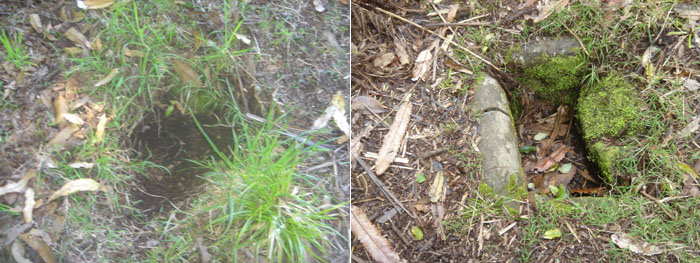
Left: All that now remains of a stone marker atop Koru PA is the hole in
which it sat. The stone was last seen in place in 2001. It sat 10 feet in from
the barrier fence facing the river on the highest point of Koru PA's eastern
end. To the right is seen the stone trough marker at
the western end of the top plateau at Koru PA. Although archaeologists refer
to this as a hearth for fires, it was strategically placed for overland alignment
geometry, using Mount Taranaki as its surveying reference marker.
The carefully constructed stone trough at the western end of
the top plateau at Koru PA was in full view of Mount Taranaki and, although
described as a hearth, is more likely to have been made for inserting an intricately
carved "Nui Pole" or totem. In consideration of the fact that Mount
Taranaki, a dormant volcano that periodically erupts and puts on magnificent
displays of fiery flashes or raining fire*, accompanied by loud reports of thunderous
explosions, it would not be unreasonable to assume that a Nui Pole would have
been erected in homage to Taranaki-Taranaich-Taranis-Tawhaki.
The regional god of thunder and lightening was
also called Tawhaki, (rendered Ta-faki)
which is not much of a departure from the names: Taranaki,
Taranaich or Taranis.
*According to the Roman poet Lucan, Taranis
was appeased by burning (Bellum civile or
Pharsalia I, 422-465).
SO, WHO WERE TARANAKI PROVINCE'S EARLIEST INHABITANTS &
WHERE ARE THEIR REMAINS?
According to local oral traditions, the people who built Koru
PA were the "friendly Maoris", also described as the kiri-puwhero
and uru-kehu (light complexion, reddish tint skin and reddish tinged, blondish
hair). These Patu-paiarehe people occupied the region for milleniums
before the coming of the late arriving Polynesian/ Melanesian cannibal warriors,
who hunted them to extinction.
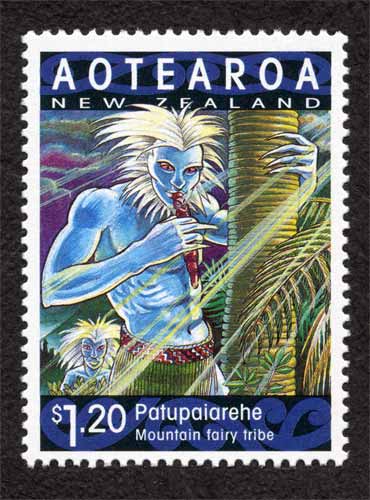
A New Zealand stamp attempts to portray, in surrealist imagery,
the pre-Maori Patu-paiarehe people, now all-too-conveniently relegated to the
realm of myth and legend. Large pockets of the pre-Maori European tribes, who
were the long-term inhabitants of New Zealand, still survived into early colonial
times and the first colonial accounts called them the "Pakeha Maoris"
(white skinned Maoris) who lived inland. The Patu-paiarehe individual shown
plays a carved putorino flute and wears a piupiu
skirt, adorned with the very Celtic or Pictish-looking
design-work that parallels the design-work now found in Maori culture.
All or most aspects of Maori culture, including associated symbolism and taonga
(treasures), were taken from the Patu-paiarehe, as the spoils of war or conquest
(muru-plunder). It is now considered to be Maori in design origin, but is, in
fact, ancient European.
J. M. McEwen researched one of these "Pakeha-Maori"
tribes called the Ngati-Hotu for over 15-years and used for reference
the writings of Hawkes Bay chiefs Raniera Te Ahiko and Paramena Te
Naonao. Other researchers gleaned information from genealogical tables related
by tribes bordering Lake Taupo and by interviews with the learned elders there.
One quotation about the Ngati-Hotu, derived from these Maori sources,
states:
Generally speaking, Ngati Hotu were of medium height and of light colouring.
In the majority of cases they had reddish hair. They were referred to as urukehu.
It is said that during the early stages of their occupation of Taupo they did
not practice tattooing as later generations did, and were spoken of as te whanau
a rangi (the children of heaven) because of their fair skin.
There were two distinct types. One had a kiri wherowhero or reddish skin, a
round face, small eyes and thick protruding eyebrows. The other was fair-skinned,
much smaller in stature, with larger and very handsome features. The latter
were the true urukehu and te whanau a rangi. In some cases not only did they
have reddish hair, but also light coloured eyes.
(See Tuwharetoa, chapter 7, page 115, by Rev. John Grace)
Reverend Richard Taylor wrote in 1855:
'Besides gods the natives believed in the existence of other
beings, who lived in communities, built pas, and were occupied with similar
pursuits to those of men. These were called Patu-paiarehe. Their chief residences
were on the tops of lofty hills, and they are said to have been the spiritual
occupants of the country prior to Maori, and to retire as they advance. The
Wanganui natives state, that when they first came to reside on the banks of
the river, almost all the chief heights were occupied by the Patu-paiarehe,
who gradually abandoned the river, and that even until a few generations ago,
they had their favourite haunts there. These may be accounts of an aboriginal
race mixed with fable; there are several things to warrant the idea that the
Maori were not the first inhabitants of the land.
The Patu-paiarehe were only seen early in the morning, and are represented as
being white, and clothed in white garments of the same form and texture of their
own; in fact, they may be called the children of the mist. They are supposed
to be of large size, and may be regarded as giants, although in some respects
they resemble our fairies. They are seldom seen alone, but generally in large
numbers; they are loud speakers and delight in playing the putorino (flute);
they are said to nurse their children in their arms, the same as Europeans and
not carry them in the Maori style, on the back or hip. Their faces are papatea,
not tattooed, and in this respect also, they resemble Europeans. They hold long
councils, and sing very loud; they often go and sit in cultivation's, which
are completely filled with them, so as to be frequently mistaken for a war party;
but they never hurt the ground…
The belief in the Patu-paiarehe is very general; many have affirmed to me that
they have repeatedly met with them. Albinos are said to be their offspring,
and they are accused of frequently surprising women in the bush.' (see Articles
from "Te Ika A Maui, NZ and its Inhabitants", by Rev Richard
Taylor, written in 1855; facsimile reprint in 1974 A.H. & A.W. Reed).
Here are some other old quotes from the books of yesteryear:
'It is most certain that the whites are the aborigines. Their colour is,
generally speaking, like that of the people of Southern Europe and I saw several
who had red hair. There were some who were as white as our sailors and we often
saw on our ship a tall young man who by his colour and features might easily
have passed for a European' (see Voyages To Tasmania & New Zealand,
by Lt. Croset)...The above observation was made in the Bay of Islands, New
Zealand.
'The Maori regales us with several tales that are supposed to illustrate
a period when the Maori people were living here on sufferance, as it were, under
the mana of the Turehu or Patupaiarehe, the true lords of the soil. Many different
names are used to denote this forest folk or fairies as our writers often term
them, though the Maori concept is not that of a diminutive fey or elf like folk,
but rather that of a people of ordinary stature and appearance, save they are
said to have been fair-skinned and fair haired' (see Maori Religion,
by Elsdon Best).
'Patupaiarehe is the name applied by the Maoris to the mysterious forest
dwelling race. An atmosphere of mysticism surrounds Maori references to these
elusive tribes of the mountains and the bush....The Patupaiarehe were for the
most part of much lighter complexion than the Maoris...their hair was of a dull
golden or reddish hue, "uru-kehu", as is sometimes seen amongst the
Maoris of today...This class of folk-tales no doubt originated in part in the
actual existence of numerous tribes of aborigines. This immeasurably ancient
light haired people left a strain of uru-kehu in most ancient tribes' (see The
Journal of the Polynesian Society, volume 30, article by James Cowan.
Commenting on a later era, Cowan interviewed an old Maori elder who spoke of
the Patupaiarehe of Mt. Ngongataha, Rotorua District. This partially wooded
area rising above the south-west shore of Lake Rotorua was the main regional
settlement of the Patupaiarehe, whom the old elder called, Ngati-Hua (hua means
"bastard" in Maori and "Ngati" is generally placed before
tribal names). The old elder described the former residents in the following
way:
'The complexion of most of them was kiri puwhero (reddish skin) and their
hair had a reddish or golden tinge we call uru-kehu. Some had black eyes, some
blue like Europeans. Some of their women were very beautiful, very fair of complexion,
with shining fair hair...'
Cowan was told by other Maori elders of the district that, many generations
previously, the Maoris set fire to the fern and forest on the slopes of the
mountain, causing much anguish to the Patupaiarehe tribe and most of them departed
northward. It's interesting to note that many very ornate little pataka buildings,
like the ones in the Auckland War Memorial Museum, were seen abandoned and deteriorating,
by early colonial observers, in the high country of Mt. Ngongataha.
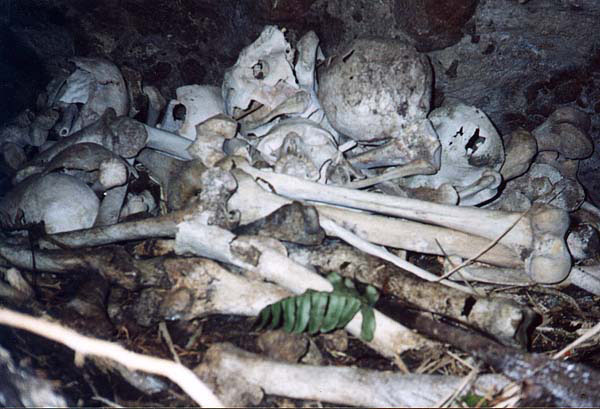
The smashed bones of the unfortunate victims of a cannibal
feast. This was the tragic fate of many of the European Patu-paiarehe people,
who were relentlessly hunted as a food source.
MORE RECENT SKELETAL DISCOVERIES OF TARANAKI'S PRE-MAORI
INHABITANTS.
Here's an excerpt from a recent newspaper article:
Old Maori skeletons get new
home
24 September 2005
By RICHARD WOOD
The remains of 12 skeletons in a formal pre-European
Maori urupa (cemetery) unearthed by contractors on a Manutahi farm, have been
removed and re-interred at Manutahi Marae by kaumatua of the Ngati Pakakohe
iwi.
No official comment could be obtained from Pakakohe, but tribal members told
the Taranaki Daily News the blessing and reinterrment happened on Tuesday.
These sources were not comfortable with the removal
of the bones.
They said the remains should possibly have been left
where they were found.
The principal South Taranaki iwi, Ngati Ruanui, was
originally called in by the police after the remains were disturbed during land
contouring earthworks for oil exploration company Swift Energy NZ Ltd, on September
13.
Ngati Ruanui chairman Syd Kahu, asked for an update
this week, said: "I have handed it all over to Pakakohe, that's all I have
to say."
Allan Cunningham, the new Swift CEO said nothing further
was being done at the site "until Ngati Ruanui decide to allow it. They
may do as they see fit, that's our position. There has been a limited amount
of fill work done where the remains were found."
Michael Taylor, a private archaeologist from Archaeology
North, Wanganui, was called in by the NZ Historic Places Trust to assess the
discovery but did no excavation.
He said the urupa "definitely pre-dates European
settlement due to the style of burial, state of the bones and the presence of
what may have been woven flax. Something like this is a significant discovery
because it is an unrecorded formal burial site. I've been in archaeology for
over 20 years and this is the first time I have seen anything like this."
Since the find, a bit more evidence has filtered through
from private sources. This tells us:
- The bones of each skeleton unearthed were in woven
bags, but the material was not flax.
- The burial site was a formally organised location,
totally unknown to the local iwi by their own admission. It's evident that
they had no history of burials at this location and in this unique manner.
The remains were of an earlier, ancient people, who had no affiliation with
the local iwi now occupying the region.
- The final burial had occurred in swamp or bog land.
From descriptions given one assumes the bodies of the deceased had first been
laid out in the open and allowed to decompose until the flesh was gone (perhaps
over a year or so). The clean bones were then, it seems, stacked into woven
bags of an unidentified material and placed into the swamp cemetery. This
practice appears to be somewhat similar to how ancient, pre-Maori New Zealanders
laid out their newly dead, then after a given time, took and stacked the clean
skeletal remains in well organised burial caves.
- Burying the dead in watery graves, such as swamps
or bogs was sometimes practiced by ancient Europeans. Generally, however,
they undertook full body burials of the newly dead in the bogs.
- No photography of the skeletal remains recovered at
the Manutahu farm was permitted.
- No forensic analysis to determine the physical anthropology
or ethnicity of the skeletal remains was permitted, although in the majority
of cases the remains were removed intact within the woven bags and all physical
materials were in a high state of preservation. These were perfect specimens
for profound scientific analysis.
The remains, which were undoubtedly pre-Maori or of ancient
Patu-paiarehe-European ethnicity have, as per usual, been whisked away and destroyed,
this time at Manutahi PA located between Hawera and Patea. This "Dark
Ages" practice of suppressing scientific investigation ensures that
we never learn the truth about our long-term history. Moreover, the progeny
of those who annihilated the earlier inhabitants of New Zealand are aided and
abetted in keeping knowledge concerning the earliest New Zealanders a deep,
dark secret.
Europeans have a right to be consulted regarding the
fate of the remains of their ancient cousin peoples. This is yet another breach
of, what should be, mutual respect for ethnic rights.
SO, WELCOME TO THE "DARK AGES" OF 2005.
As was said earlier, 'it's virtually all corporate
science now' and information is carefully vetted, seived and sanitised by
social engineers before it's deemed suitable for presentation to the masses.
Such is the substance and content of the TV series, Frontier Of Dreams...
or such is the reason behind the destruction, instead of forensic analysis,
of ages-old skeletal remains from a Taranaki swamp.
Section 3

